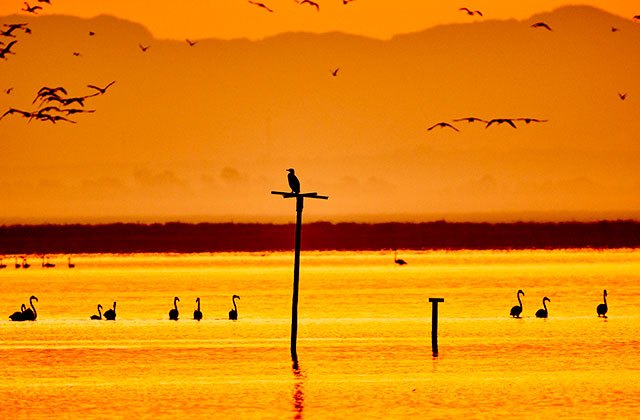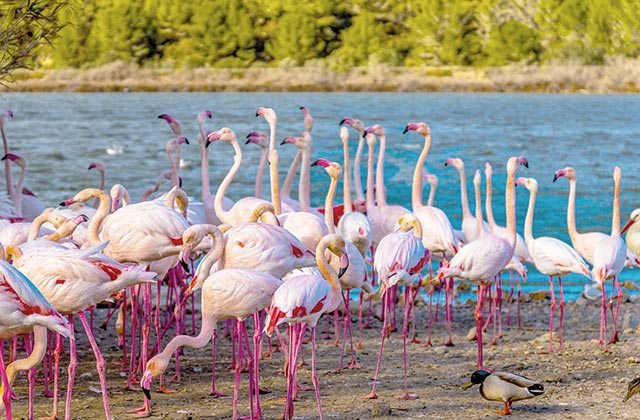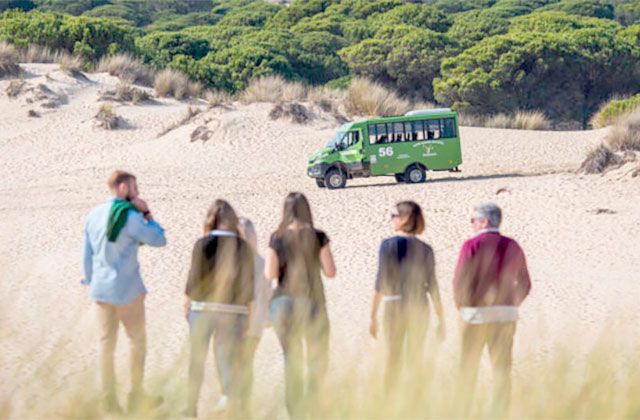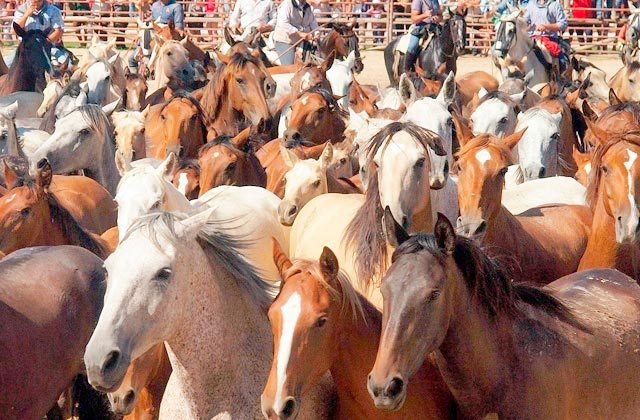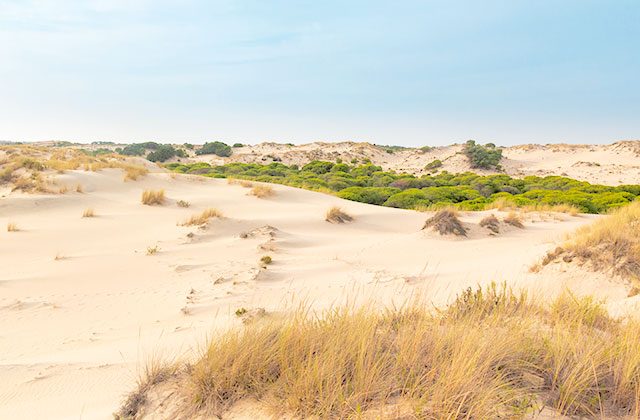
Ways to discover Doñana National Park
Doñana National Park is one of the natural places par excellence of Andalusia and is the largest ecological reserve in Europe. It spans the provinces of Huelva, Cádiz, and Seville and is one of the most beautiful protected areas we have in the south of Spain.
Thanks to its unique biodiversity in Europe, a visit to Doñana Park is a must not only for biologists and birdwatchers, but for any person or family who wants to enjoy a special day in a beautiful landscape full of things to see and do.
The marsh is one of the most beautiful areas to see in the Park, as well as the dunes or the beaches. For nature lovers, this protected area is a key stopover for migratory birds, making birdwatching one of the must-do activities. The Mediterranean forest or the stone pine are of high ecological value for the species found in them.
The fauna of the Park is unique in Europe. Over 300 species of birds live here, which is why it is recognized as a Special Protection Area for Birds. In addition, Doñana is home to more than 37 types of mammals, with the Iberian lynx being one of the most notable.
Visiting Doñana Park is a luxury where you can spend a day learning and enjoying the whole family in this beautiful biosphere reserve.
What to do in Doñana at any time of the year
Any time of the year is perfect to visit the Doñana National Park because each season has its own charm. However, if we had to recommend some seasons, autumn and winter are ideal to visit this biosphere reserve. Even so, here we explain what to see and what to do in each of the seasons.
Spring
Spring is a good time to visit Doñana since the summer heat has not yet arrived, and the marshes are at their maximum beauty. This time of the year is also the best time for breeding birds and for the arrival of many of them. So, if you are a bird lover, spring is an excellent time to observe them.
It is also a good time to observe the new members of the mammal family, such as wild boars. If you walk through the ecosystems of Doñana, you will see some fawns or wild boar calves running around or suckling.
And how could it be, otherwise, spring is the best time for the flora, as they are more alive and colorful than ever, so you can enjoy some of the most beautiful landscapes of the year.
Summer

Summer is the hottest season of all, but still there are plenty of things to see and do in Doñana during this time. The activity par excellence is to visit the beaches, although it is not the only one. The marshes may still retain some water, and you can visit them and see herons, flamingos, and storks. If the water has dried up due to rising temperatures, the area becomes ideal for mares to graze.
The village of El Rocio is mythical in this area of Doñana, so visiting it and enjoying this special and picturesque place will be one of the experiences you should not miss, as well as its hermitage.
And if the heat gets intense, a walk along the paths near the Rocina or the Acebrón, under the shade of the trees, is a good plan for a summer afternoon in Doñana.
Autumn
Autumn is one of the best seasons to visit the Doñana National Park, and it is at this time that one of the most special and amazing events occurs: the bellowing of the deer. It involves listening to the splendorous bucks that occur after the roaring of the fallow deer. It is also common at this time to see them eating and running through the woods. The lynxes born in spring start their solitary journey to start hunting, so you may find some of them around in autumn.
One of the things you can do during this season is to spot the imperial eagle, as well as warblers, redstarts, and many other birds. It is also common in autumn to see partridges fluttering about, or to begin to see the typical flora of this season such as mandrake, autumn bells, or saffron.
Winter
The winter season, along with autumn, is one of the best seasons to visit Doñana because temperatures are lower, and there are fewer people. The marshes create a beautiful panorama at this time of the year, making it one of the things you can do in the park. In addition, it is common in winter to see the mares and wild cows grazing in the area. You might even spot a hare running in the puddles in the marshes. Another of the most common species at this time of year is the short-eared owl, along with a host of other species, such as goldfinches and the female hen harrier, as well as many migratory birds.
Horseback riding, biking, off-road trails, or hiking are some of the activities you can do in winter to enjoy the park’s winter landscape, as well as all the previously mentioned wildlife.
Emblematic fauna of the Doñana National Park
The fauna of Doñana Park is very diverse, with numerous species of birds, reptiles, amphibians, and mammals. During the winter season alone, the number of birds can reach more than 200,000.
However, among the fauna of the Park, there are some emblematic species, such as the imperial eagle or the Iberian lynx.
The Iberian lynx is a mammal that stands out for being a very rare species, although fortunately, it has recently moved from being critically endangered to being classified as vulnerable. The Iberian lynx is a unique and exclusive species to the Iberian Peninsula and belongs to the feline family, known as the great Mediterranean cat. The males usually weigh 13 kg, while the females weigh 10 kg, with long legs and a shorter tail. Something very characteristic are its large ears that end with black hairs on the tip.
It is the emblem of Doñana par excellence, and thanks to conservation and protection efforts, the population increased from 94 individuals throughout Andalusia to more than 2,000.
The Iberian imperial eagle is another iconic species of Doñana National Park, serving as the park’s winged emblem. It can reach up to 2.2 meters in wingspan and weigh around 3 kg. Like the lynx, this bird of prey has also faced periods of endangerment, which is why great efforts have been made to conserve it. There are currently approximately 500 pairs of imperial eagles in the Iberian Peninsula, which has meant an increase in the number of this species. Despite the conservation efforts, this winged symbol of Doñana continues to face the threat of electrocution from electricity power lines.
Routes to visit Doñana and practical advice
Visiting the Doñana National Park is an experience that can be done independently or with guided tours. Any time of the year offers visits by boat, on foot, horseback, bike, or ATV, and several companies offer guided and private tours. Here, we highlight some of the best routes you can take to ensure you don’t miss anything during your visit to Doñana.
One of the things you should do is to book your guided tour in advance if that is what you want. Many companies are offering these services, with a wide variety of routes and options available.
Another tip to keep in mind is whether you are traveling with children or not, and the time of the year. Summer is one of the busiest and hottest seasons, so we recommend wearing comfortable and cool clothes.
Autumn and winter are the best times to visit Doñana, and the landscape is among the most beautiful during this season. Additionally, the rains appear at this time, so be sure to choose a route that is most convenient for those days.
Another thing to consider before your trip to Doñana National Park, is to check what things you prefer to see or visit. We have previously mentioned what is predominant in each season of the year in the park, so take a look and choose the season according to what you want to see.
Cruise aboard Real Fernando ship
To visit both the Natural Park and the National Park using most of the same route, there is the option of making the crossing from Sanlúcar de Barrameda in the ship Real Fernando, making two interesting stops on a journey that takes about three hours approximately.
Along the way you will observe birds such as flamingos and herons, which are easily seen from the boat.
Acebuche itinerary
This is an off-road route through the most iconic ecosystems of the Doñana Park. It lasts approximately 4 hours, covering about 70 km. As it is a guided route, the guide-driver will explain the characteristics of the route and will show you the most important areas of Doñana.
It is necessary to make a reservation in advance to enjoy this itinerary. Here is the contact information so you don’t miss this beautiful route through the ecosystems of Doñana.
Phone: +34 959 430432 – +34 959 430451 / Fax: +34 959 430451
E-mail: [email protected]
Tour from Sanlúcar de Barrameda
It is one of the most iconic and special routes to visit Doñana. It is an itinerary by boat from Sanlúcar de Barrameda and in 4×4 vehicles. It is one of the ways to see the entire park from the Real Fernando ship, where you can sail along the Guadalquivir River from the Bajo Guía. From the dunes to the marshes, your visit will be in off-road vehicles, then by boat to return to Sanlúcar. On this tour, you will not only see the ecosystems and the park, but you will also get to enjoy Doñana’s beaches.
If you want to enjoy the Doñana National Park most especially, we recommend you make your reservation and get information about schedules and rates at this telephone number: +34 956 363 813.
Enjoy Doñana on camelback
One of the most unique ways to visit the park is by camel. The route starts in all-terrain vehicles and ends with a camel ride through the park. With this visit, you will not only be able to see all the most important ecosystems of Doñana, but you will also get to see its flora and fauna in its splendor and the Matalascañas Dune Park. This visit can also include a lunch menu if you wish, as well as a six-and-a-half-hour tour.
If you want to visit Doñana in this special way, book here: +34 959 430 432.
Private tours
This is one of the ways to visit the park and some of the most emblematic places, such as the Iberian lynx territory. This tour lasts about 3 hours and a half, during which you will visit the Doñana Park, Coto del Rey, the marshes, and the forest area in a private vehicle with an exclusive guide for the people in the group. In addition, during this tour, you can choose whether you want to see the Iberian lynx area or the ornithology area. A picnic and photographic material, binoculars, or telescope can be included to improve visibility.
This company offers different types of tours, which you can check and book here.
Charco de La Boca trail
Another way to visit Doñana is on foot, and this trail near the mythical village of El Rocio is one of the best known and beautiful both for where it begins and where it ends, at the Charco de la Boca. This trail has an extension of about 4 kilometers and is of low difficulty, making it ideal for anyone. Along the way, you will enjoy the beautiful landscape drawn by the marshes and all the scrubland areas.
When the trail ends and arrives at Charco de la Boca, you will see a jewel of nature, such as the lake that hosts a large number of birds. We recommend doing this trail during the bird migratory season to observe the greatest number of species.
More things to see
El Rocío
You cannot leave Doñana National Park without visiting the famous village of El Rocio. Extremely famous for the massive Pilgrimage of El Rocio, this architectural complex is well worth a stop on your way. The first thing that catches our attention are its dirt roads. This is because the asphalt has not reached any corner of this imperturbable population.
It is worth walking through the streets in search of the best postcard and, of course, enter the Ermita del Rocío. Recently built in the 60s, this temple houses one of the world’s most venerated carvings, the Virgen del Rocio. The festival around the Virgin, held during the weekend of Pentecost Sunday, gathers more than one million people every year. This route is partly shared with the reserve of Doñana.
Approaching Asperillo
Doñana holds surprises until the end of the visit. An example of this is the Asperillo Cliff, located in the coastal border. The place is a show of contrasts, with a range of ochre and red colours, which change according to the time of day.
This 30-metre sandy cliff really impresses due to its many kilometres in length, the highest in Europe of its type, partly Natural Monument, which dominates the coastal landscape. Besides the obvious scenic value, it has a great geological and ecological importance. You can discover it by taking the well marked paths such as Cuesta Maneli, where you can also find out about the evolution of dunes through the different ecosystems, leading to the cliff itself.
See the release of mares
For more than 500 years, farmers in Almonte come to the village with mares and foals used for working throughout the day in Doñana National Park, to celebrate the annual Cattle Fair. This event is known as Saca de Yeguas. Every June 26th you will be able to attend the traditional parade where mares are grouped and guided by their carer.
Enjoy its beaches
Among different types of landscapes we find in Doñana we have dunes, marshes and pine forests, but also 27 kilometres of completely unspoilt beaches. If you delay the walk until dusk, you will contemplate the spectacular sunset from this important and well-known nature reserve.
Moving dunes
The moving dunes are part of this spectacular scenery. They form on the beach where the wind pushes the sand from the coast inland, forming mountains of sand that will grow and continue moving to meet the marsh. Although the presence of dunes is permanent on the coast of Huelva and Cádiz, the most impressive ones are located between the town of Matalascañas and the mouth of Guadalquivir river.
Sustainability
As we have already mentioned, Doñana National Park is a biosphere reserve, the largest in Europe. The main objective is to protect the park’s biodiversity, and for this reason, great efforts are made in its preservation.
Therefore, we recommend visiting Doñana responsibly, being mindful of the importance of the place you are in. While many people visit to enjoy the flora and fauna of Andalusia’s green lungs and to learn, alongside birdwatchers, researchers, and ornithologists, the common goal must be the care of the facilities and respect for the entire park. This includes respecting the ecosystems, not disturbing the animals we encounter, and, above all, avoiding leaving bags or litter behind.
We kindly ask that you follow the guides’ instructions closely, or if you are visiting on your own, make respectful use of the park to protect the unique biodiversity found in Doñana.
Curiosities about Doñana
Where does the name Doñana come from?
It was in the 16th century when Doña Ana Magdalena Gómez de Silva and Mendoza decided to reside in what at that time was just a forest and in together her husband, Don Alonso Pérez de Guzmán, seventh Duke of Medina Sidonia, built what todays is the Doñana Palace.
The landscape of the pestles
In 1797, the famous painter Francisco de Goya resided as a guest of the Duchess of Alba, at that time Doña Cayetana de Silva, in the Doñana Palace. During his stay the painter took several portraits of the widow, so it is said that it was here that the painter made his two Majas
Lawrence de Doñana
The dunes of Doñana were the setting chosen by the cameras of David Lean to recreate the desert in the film Lawrence of Arabia.
‘Astarté del Rocío’
Astarte is the Tartessian goddess of fertility. This goddess is associated with both the waters and the moon. Some historians maintain that there was a temple dedicated to this goddess where today is the Hermitage of the Virgen del Rocío is located. All this is reinforced by the fact that this Virgin, besides considering her the Mother of the Marshes, is called the White Dove and Astarte was also represented by a white dove.
The ‘panda’ that was born in Doñana
After the salvation of Doñana during Franco’s dictatorship (the dictator intended to turn the park into a eucalyptus field, but ended up giving up), an organization was created to raise funds and create a scientific reserve here, in this way the World Wide Found was born. World for Nature). The funny thing about this is that despite being born in this park, the logo of the organization is not an Iberian lynx, but a panda.
Eucalyptus
Another curiosity about Doñana Park is that there was once a plan to drain the marshes and plant eucalyptus trees in their place, with the goal of creating a timber industry. Fortunately, this did not happen, thanks to the intervention of the scientist José Antonio Valverde, who worked to prevent it.
Biodiversity
Maybe you already know this, but Doñana has an extension that covers three provinces: Huelva, Cadiz, and Seville. It is unique in Europe for its biodiversity and its status as a protected area.
Golden Lung
It is called the Golden Lung of Andalusia and was once referred to as the Lung of Europe. It hosts three species that have been endangered, as it provides the appropriate ecosystems and conditions for their protection, conservation, and repopulation. These species include the Iberian lynx, which is no longer classified as endangered, the Iberian imperial eagle, and the spur-thighed tortoise.
What are the natural wonders of Andalucia?
WHERE TO STAY

Hotel Fuerte El Rompido
Hotel Fuerte El Rompido is one of the most beautiful hotels in the area due to its spectacular location on a hill that dominates the natural area of Río Piedras and also offers a perfect place to enjoy the prawn route. Besides, it also features aesthetic Andalusian architecture that harmonizes with its surroundings and its good cuisine based on seafood. An ideal place to rest and to practice sports surrounded by nature.
